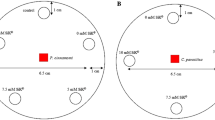Abstract
High performance liquid chromatography analysis of different parts of Sclerotium rolfsii-infected and healthy seedlings of chickpea (Cicer arietinum) was carried out to examine the status of phenolic compounds. Three major peaks that appeared consistently were identified as gallic, vanillic and ferulic acids. Gallic acid concentrations were increased in the leaves and stems of infected plants compared to healthy ones. Vanillic acid detected in stems and leaves of healthy seedlings was not detected in infected seedlings. There was a significant increase of ferulic acid in those stem portions located above the infected collar region compared to minimal amounts in the roots of healthy seedlings. In vitro studies of ferulic acid showed significant antifungal activity against S. rolfsii. Complete inhibition of mycelial growth was observed with 1000 μg of ferulic acid/ml. Lower concentrations (250, 500 and 750 μg/ml) were also inhibitory and colony growth was compact in comparison with the fluffy growth of normal mycelium. Higher amounts of phenolics were found in the stems and leaves of S. rolfsii-infected seedlings in comparison to the healthy ones. A role for ferulic acid in preventing infections by S. rolfsii in the stems and leaves of chickpea plants above the infection zone is therefore feasible.
Similar content being viewed by others
References
Aycock, R. 1966 Stem rot and other diseases caused by Sclerotium rolfsii. NC Agricultural Experimentation Station Technical Bulletin 174, 202.
Binutu, O.A. & Cordell, G.A. 2000 Gallic acid derivatives from Mezoneuron benthamianum leaves. Pharmaceutical Biology 38, 284-286.
Coley, P.D. 1983 Herbivory and defensive characteristics of tree species in a low land tropical forest. Ecological Monographs 53, 209-233.
Demyttenaere, J.C.R., Willemen, H.M., Carmen Herrera, M.D. & Verhe, R. 1997 Antifungal properties of essential oil components. Proceedings of Twenty-eighth International Symposium on Essential oils, Eskisehir, Turkey, 0-1, 1-3 September.
Donovan, J.L., Meyer, A.S. & Waterhouse, A.L. 1998 Phenolic composition and antioxidant activity of prunes and prune juice (Prunus domestica). Journal of Agriculture and Food Chemistry 46, 1247-1252.
Feeny, P. 1976 Plant apparency and chemical defense. Recent Advances in Phytochemistry 10, 1-40.
Goldstein, J.L. & Swain, T. 1965 The inhibition of enzymes by tannins. Phytochemistry 4, 185-192.
Graham, H.G. 1992 Stabilization of the Prussian blue color in the determination of polyphenols. Journal of Agriculture and Food Chemistry 40, 801-805.
Hagerman, A.E. & Butler, L.G. 1989 Choosing appropriate methods and standards for assaying tannin. Journal of Chemical Ecology 15, 1795-1810.
Hagerman, A.E. & Klucher, K.M. 1986 Tannin-protein interactions, In: Plant Flavonoids in Biology and Medicine: Biochemical, Pharmacological and Structure Activity Relationships, eds. Cody, V., Middleton, E. & Harborne, J.B. pp. 67-76. New York: Alan R. Liss. ISBN 0-84515063-4.
Hagerman, A.E. & Robbins, C.T. 1987 Implications of soluble tannin-protein complexes for tannin analysis and plant defence mechanisms. Journal of Chemical Ecology 13, 1243-1259.
Hagerman, A.E., Reidl, K.M., Jones, G.A., Sovik, K.N., Ritchard, N.T., Hartzfeld, P.W. & Riechle, T.L. 1998 High molecular weight plant polyphenolics (tannins) as biological antioxidants. Journal of Agriculture and Food Chemistry 46, 1887-1892.
Lugasi, A., Almeida, D.P.F. & Dworschak, E. 1999 Chlorogenic acid content and antioxidant properties of potato tubers as related to nitrogen fertilisation. Acta Alimentaria 28, 183-195.
Majinda, R.R.T., Motswaledi, M., Waigh, R.D. & Waterman, P.G. 1997 Phenolic and antimicrobial constituents of Vahlia capensis. Planta Medica 63, 268-270.
McManus, J.P., Davis, K.G., Lilley, T.H. & Haslam, E. 1981 Journal of Chemical Society Chemical Communications 7, 309-311.
Millar, R.L & Higgins, H.J. 1970 Association of cyanide with infection of birdsfoot trefoil by Stemphylium loti. Phytopathology 60, 104-110.
Mole, S. & Waterman, P.G. 1987 A critical analysis of techniques for measuring tannins in ecological studies. Oecologia 72, 137-147.
Nicholson, R.L. & Hammerschmidt, R. 1992 Phenolic compounds and their role in disease resistance. Annual Review of Phytopathology 30, 369-389.
Punja, Z.K. 1985 Biology, ecology and control of Sclerotium rolfsii. Annual Review of Phytopathology 23, 97-127.
Punja, Z.K. & Damiani, A. 1996 Comparative growth, morphology and physiology of three Sclerotium species. Mycologia 88, 694-706.
Rhoades, D.F. & Cates, R.G. 1976 Towards a general theory of plant antiherbivore chemistry. Recent Advances in Phytochemistry 10, 168-213.
Salisbury, F.B. & Ross, C.W. 1986 Lipids and other natural products. In: Plant Physiology, pp. 268-287. Delhi: CBS Publishers & Distributors.
Singh, U.P., Sarma, B.K., Singh, D.P. & Amar Bahadur 2002 Plant growth-promoting rhizobacteria-mediated induction of phenolics in pea (Pisum sativum) following infection with Erysiphe pisi. Current Microbiology 44, 396-400.
Stoessl, A. 1983 Secondary plant metabolites in preinfectional and postinfectional resistance. In: The Dynamics of Host Defence. eds. Bailey, J.A. & Daverall, B.J. pp. 71-122. New York: Academic Press. ISBN 0-12-073460-5.
Tamari, K. & Kaji, J. 1954 Biochemical studies of the blast fungus Pyricularia oryzae Cav., the causative fungus of the blast disease of the rice plants-1: Studies on the toxins produced by blast fungus. Journal of the Agricultural Chemical Society, Japan, 29, 185-190.
Author information
Authors and Affiliations
Rights and permissions
About this article
Cite this article
Sarma, B., Singh, U. Ferulic acid may prevent infection of Cicer arietinum by Sclerotium rolfsii . World Journal of Microbiology and Biotechnology 19, 123–127 (2003). https://doi.org/10.1023/A:1023205522032
Issue Date:
DOI: https://doi.org/10.1023/A:1023205522032




